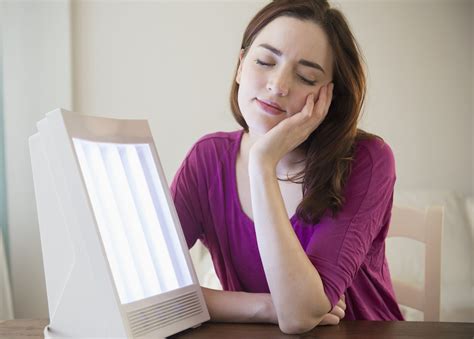The concept of light box therapy has been gaining momentum in recent years, particularly among individuals struggling with Seasonal Affective Disorder (SAD) and other forms of depression. But what exactly is light box therapy, and how does it work?
To understand the benefits of light box therapy, it’s essential to delve into the science behind it. Research has shown that exposure to specific wavelengths of light can have a profound impact on our mood, energy levels, and overall well-being. This is because light plays a crucial role in regulating our circadian rhythms, which are the internal processes that govern our sleep-wake cycles.
When we’re exposed to natural sunlight, our brains receive a signal that helps regulate our circadian rhythms. This signal is sent to the suprachiasmatic nucleus (SCN), a small group of cells in the hypothalamus that acts as our internal clock. The SCN then triggers the release of various hormones, including serotonin and melatonin, which help regulate our mood, appetite, and sleep patterns.
However, during the winter months or in regions with limited sunlight, our brains may not receive enough light to regulate our circadian rhythms properly. This can lead to a range of symptoms, including fatigue, lethargy, and depression. It’s here that light box therapy comes into play.
A light box is a device that emits a specific wavelength of light, typically in the range of 10,000 lux. This is much brighter than a standard light bulb, which typically emits around 200-500 lux. By sitting in front of a light box for a specified period each day, usually 20-30 minutes, individuals can receive the light their brains need to regulate their circadian rhythms.
But how does light box therapy actually work? The process is quite complex, involving a range of physiological and psychological mechanisms. When we’re exposed to the light from a light box, our brains receive a signal that helps regulate our SCN. This can lead to an increase in the production of serotonin, a neurotransmitter that helps regulate our mood, appetite, and sleep patterns.
In addition to its effects on serotonin, light box therapy has also been shown to impact other neurotransmitters, including dopamine and endorphins. These chemicals play a crucial role in regulating our mood, motivation, and overall sense of well-being.
One of the most significant benefits of light box therapy is its ability to provide relief from SAD symptoms. Studies have consistently shown that light box therapy can be an effective treatment for SAD, with many individuals experiencing significant improvements in their mood and energy levels.
But light box therapy isn’t just limited to SAD. It’s also been used to treat other forms of depression, including non-seasonal depression and bipolar disorder. Additionally, light box therapy has been shown to be effective in reducing symptoms of anxiety, insomnia, and chronic fatigue syndrome.
So, how can you get started with light box therapy? The first step is to consult with a healthcare professional, who can help determine whether light box therapy is right for you. They may recommend a specific type of light box, as well as a treatment schedule tailored to your individual needs.
When selecting a light box, it’s essential to consider a few key factors. First, look for a device that emits a full-spectrum light, which includes all the colors of the visible spectrum. This type of light is more effective at regulating our circadian rhythms than other types of light.
Second, consider the intensity of the light. A light box with an intensity of 10,000 lux is typically considered standard, but some devices may emit more or less light. It’s also essential to choose a device with a UV-free light, as UV radiation can be harmful to our skin and eyes.
Finally, think about the size and portability of the device. Some light boxes are compact and portable, making them easy to take on the go. Others may be larger and more stationary, requiring a dedicated space in your home or office.
In conclusion, light box therapy is a highly effective treatment for a range of conditions, including SAD, depression, and anxiety. By understanding the science behind light box therapy and selecting the right device, individuals can take the first step towards improving their mood, energy levels, and overall well-being.
What is the ideal duration for light box therapy sessions?
+The ideal duration for light box therapy sessions can vary depending on individual needs, but most studies recommend 20-30 minutes per session.
Can light box therapy be used in conjunction with other treatments?
+Yes, light box therapy can be used in conjunction with other treatments, including medication and psychotherapy. However, it's essential to consult with a healthcare professional before starting any new treatment.
Are there any potential side effects of light box therapy?
+While light box therapy is generally considered safe, some individuals may experience side effects such as headaches, eye strain, or nausea. It's essential to follow the recommended treatment schedule and consult with a healthcare professional if you experience any adverse effects.
As we continue to explore the benefits and mechanisms of light box therapy, it’s clear that this treatment has the potential to revolutionize the way we approach mental health. By harnessing the power of light, individuals can take control of their mood, energy levels, and overall well-being, leading to a happier, healthier life.
In the future, we can expect to see even more advances in light box therapy, including the development of newer, more effective devices and treatment protocols. As our understanding of the science behind light box therapy continues to grow, we can expect to see even more innovative applications of this technology, from treating a range of mental health conditions to enhancing our overall quality of life.
For now, one thing is clear: light box therapy is a powerful tool that has the potential to transform the lives of millions of people around the world. By embracing this technology and working with healthcare professionals to develop personalized treatment plans, individuals can take the first step towards a brighter, healthier future.


